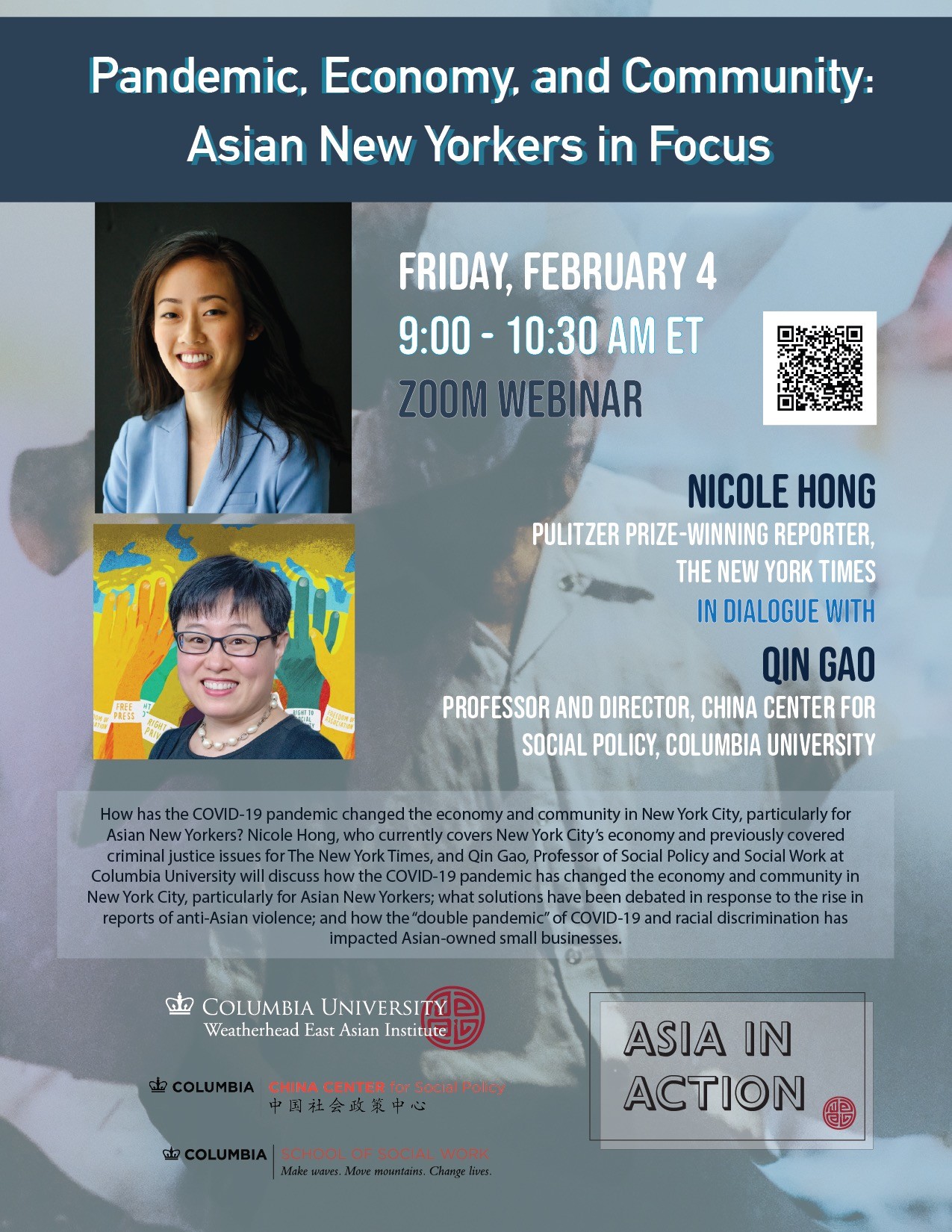New York Times Reporter Nicole Hong Underscores COVID-19’s Impacts on Asian New Yorkers

The lasting impacts of the COVID-19 pandemic in New York, one of the early epicenters of the virus, continue to shape daily life, and have posed particular challenges for the Asian community here. During a virtual discussion on February 4, 2022, titled “Pandemic, Economy, and Community: Asian New Yorkers in Focus,” The New York Times reporter Nicole Hong and China Center for Social Policy Director and WEAI Professor Qin Gao discussed the multifaceted consequences of the pandemic, from the toll of the virus itself on a disproportionately elderly population to virulent anti-Asian hate.
According to Hong, who covers New York City’s economy and previously covered criminal justice issues for The New York Times, the economic fallout from the pandemic is markedly different from that of the 2008 financial crisis. Unlike in 2008, when almost all sectors of the job market were impacted, the pandemic affected service industry jobs the most, positions that are often staffed by immigrant––including Asian––workers. Hong listed nail salons, dry cleaners, and restaurants as businesses often staffed by immigrants of Asian descent which struggled to stay afloat during mandatory and self-imposed quarantines.
Manhattan’s Chinatown was especially hard hit, Hong said. In addition to the fact that many of the restaurants in the neighborhood were small, cash-only shops unequipped for a shift to a delivery-based operation, fear and misinformation in the early days of the pandemic led many people to conflate the virus, which first broke out on a large scale in the Chinese city of Wuhan, with Chinese people themselves. Hong spoke of an interview with a doctor who received a question from a patient asking if it was safe to continue eating Chinese food. Chinese Americans and immigrants were also among the earliest to begin social distancing in New York, which hurt businesses in January 2020 that relied on Lunar New Year celebrations.
Chinatown’s Asian residents, a disproportionate number of them over the age of 65, have been forced to grapple not only with fears of contracting the virus and a blow to local businesses, but also physical threats to their safety as a result of anti-Asian attacks. Much has been written about the rash of violence against people of Asian descent, a phenomenon that continues to dominate headlines with the recent horrific killings of Michelle Go and Christina Yuna Lee in New York. Professor Gao noted her own behavioral shifts since the start of the pandemic––heightened vigilance when commuting to work and the precautions she feels she must take for the safety of herself and her family––and her research surveying concern and coping strategies among members of the Chinese community.
This outbreak of hate crimes has been difficult to address. The Asian American community is not a monolith, and it has been a challenge to reach political agreement within this varied––and growing––community. An initial proposal to increase the number of Asian American police officers patrolling the community has not had the desired effect. Community members have raised concerns about the bureaucratic hoops required to report a hate crime, the difficulty of classifying attacks as racially motivated, and inaction by the police following a report. For Hong, the questions to watch for moving forward will be: What agenda comes out of the political movement within the Asian community, and what are the areas of agreement that the city will actually implement?
The event, "Pandemic, Economy, and Community: Asian New Yorkers in Focus," was sponsored by the Weatherhead East Asian Institute and cosponsored by the China Center for Social Policy. Learn more about the Weatherhead East Asian Institute's Asia in Action initiative here.
